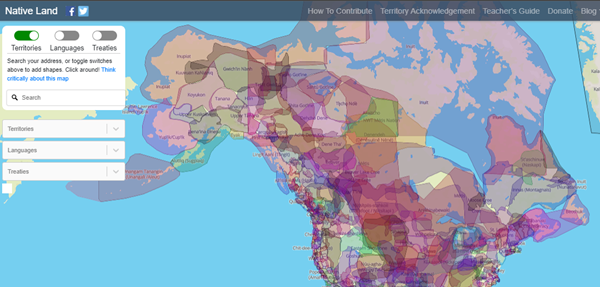St. Clair College Traditional Land Acknowledgment
St. Clair College would like to recognize and acknowledge that it sits on the Three Fires Confederacy’s traditional territory of the Ojibwe, Odawa, and Potawatomi nations. We would also like to acknowledge the many other tribes and indigenous nations that call this beautiful land home. We give thanks to the land and surrounding Water for sustaining us.
Image from Native-Land.ca captured August 26, 2020
This acknowledgment is part of how we recognize that we are guests on these lands and that Indigenous peoples were here long before St. Clair College, Chatham, Windsor, Ontario or even Canada existed. Take a look at the image above. It probably does not look like the map of Canada you may have seen before. That is because it does not show provinces, but rather it shows territories of Indigenous peoples. This image was taken from Native-Land.ca, a not-for-profit organization that is attempting to map the traditional territories, languages and treaties of Indigenous peoples as a way for non-indigenous people to explore the land they live on.
Victor Temprano (2017), initial creator of Native-Land.ca, wrote “I wanted to make something to reach out to non-Indigenous people (like myself), something that would engage them in with Indigenous history in a friendly and interesting way. Indigenous people already know their territory — it’s the ‘settlers’ who needed to have a look at the information I was collecting. I wanted people to have Indigenous names and lands in mind as they went about their days.” Feel free to explore
Native-Land.ca in more depth.
“To the settler mind, land was property, real estate, capital, or natural resources. But to our people, it was everything: identity, our connection to the ancestors, the home of non-human kinfolk, our pharmacy, our grocery store, our library, the source of everything that sustained us. Our lands were where our responsibility to the world was enacted, sacred ground. It belonged to itself; it was a gift, not a commodity, so it could never be bought or sold.” (Robin Wall Kimmerer, (2013), Braiding Sweetgrass: Indigenous Wisdom, Scientific Knowledge and the Teachings of Plants).
The elders tell us that all four colours of man have a responsibility to take care of the land because the soil that we walk on has become the earth in which their ancestors have also been laid to rest. They have now become a part of this Sacred land. We take care of it, not for ourselves but for our future generations. For our children and their children’s children.


